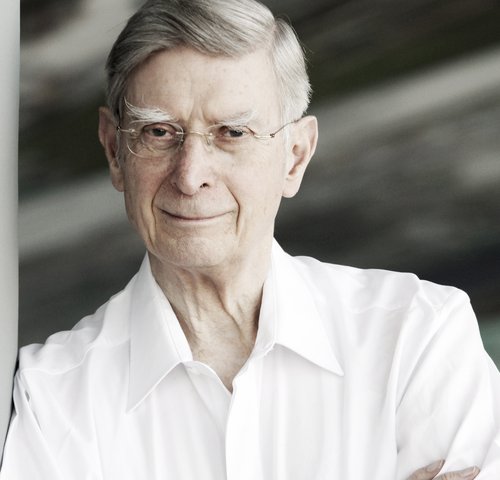The (almost) 500th time is possibly the best for Boston Symphony and Brahms

Herbert Blomstedt returned to the Boston Symphony Orchestra on Thursday with a program of Haydn and Brahms.
Herbert Blomstedt’s return to the Boston Symphony podium Thursday night picked up right where his last performance with the orchestra in July left off — which is to say with music by Franz Josef Haydn.
This week’s offering was the Cello Concerto No. 1, a mid-1760s score that straddles both Baroque- and Classical-era formal procedures for the genre. In the performance’s only major concession to period practice, Blomstedt led a drastically-reduced ensemble of just twenty players.
Technically, the Haydn concerto’s solo demands are Herculean by any measure: often high-tessitura and exposed, offering nowhere for a soloist to hide.
Last night, the spotlight was held by Truls Mørk. A cellist of the first rank and an exceptional musical thinker to boot, Mørk is precisely the type of musician you should want to hear playing this piece.
His reading on Thursday did not disappoint, the opening movement played with beautiful tone: rich, clean and songful. Throughout, Mørk’s intonation was spot-on and each phrase articulated with the utmost precision. The slow movement showcased moments of quiet intensity and judicious use of vibrato, while the finale let loose with vigor, Mørk tossing off its cascades of bariolage with understated brilliance.
He rewarded a fervent ovation with a spacious account of the “Sarabande” from Bach’s D-minor Cello Suite.
The pared-down accompaniment was by turns graceful and dancing in the first movement, tranquil in the second, and crisp in the finale. Soloist and orchestra were scrupulously balanced, the leaner BSO complement never overshadowing Mørk nor sounding scrawny. Ensemble-wise, though, there were some spotty moments, particularly involving ornamental passages in the outer movements and snap rhythms in the first.
No such unevenness marred the full orchestra’s performance of Johannes Brahms’s Symphony No. 1 that followed intermission. This 1876 standard is a BSO favorite: The ensemble has played it nearly five hundred times. Blomstedt’s account of the piece on Thursday ranks among the best.
Never lacking for direction, it was rhythmically taut and bristling with drama. Tempos in the outer movements always drove purposefully. The slow second, paced a mite generously, didn’t dawdle. Neither did the lilting third, which burbled amiably.
Texturally, Blomstedt’s reading was lucid. That’s not to say that he cleaned up Brahms’s sometimes thick instrumental writing, though seating the violins on opposite sides of the podium did illuminate the work’s stereophonic moments, especially in the finale. If anything, the conductor seemed to revel in the score’s stout sonorities, especially drawing out the music’s rich, involved writing for low instruments. But he didn’t let the BSO’s sound devolve into an oleaginous blob.
Rather, Blomstedt allowed the score’s moving parts to speak to and through one another. Thus, the contrary-motion themes of the first movement’s introduction were distinctly etched. The lovely third-movement woodwind solos were never smothered by the strings even though there was rarely any sense of the strings being held back. And the exchange of solo and sectional voices in the second movement — highlighted by concertmaster Tamara Smirnova’s duet with principal horn James Sommerville — was perfectly calibrated.
The overriding result was a Brahms First of uncommon organic logic, sweep and expressive power. All of the little motives that tie the piece together were given free rein to speak, and speak they did. Indeed, when the grand, final peroration finally rolled around, there was a true sense of arrival and of a triumph hard won. That’s a tricky feat to accomplish, especially in music as familiar as this. Thursday’s house seemed to recognize as much, receiving the effort with thunderous applause.
The program repeats 8 p.m. Saturday and Tuesday at Symphony Hall. bso.org; 888-266-1200
Posted in Performances





Posted Jan 20, 2019 at 10:29 pm by Anonymous
A beautiful review. I wanted to get to this concert from Amherst, using public transportation. On inquiry I learned that the BSO sends a van to Worcester, which leaves for Symphony Hall at 10 A.M. The Peter Pan Bus from Amherst doesn‘t arrive until 11. You can imagine my disappointment.
Sincerely,
An octogenarian